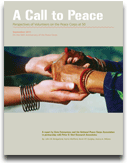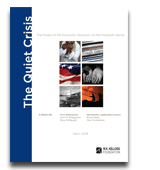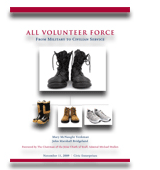NATIONAL SERVICE AND CIVIC ENGAGEMENT
Reimagining Service
The National Conference on Citizenship launched an initiative challenging
individuals to sign on to its Reimagining Service Principles:
Principle 1: The volunteer ecosystem is more effective when all sectors participate in its evolution.
Principle 2: Make volunteering a core strategic function, not an add-on.
Principle 3: Focus volunteer engagement on true community needs.
Principle 4: In order to get a return, you have to invest.
Civic Health Index
2021
Since 2006, Civic, the National Conference on Citizenship (NCoC), and other partners have assembled top experts and institutions to release the Civic Health Index to better understand an array of civic health indicators that are measurable and movable.
NCoC defines “civic health” as the way that communities are organized to define and address public problems. Overall, most trends in civic health have been on the decline, including stagnating levels of civic education, dwindling community group membership, and worsening interpersonal and institutional trust. At the same time, there are signs of a vibrant civic nation with increased rates of volunteerism, political knowledge, and casting ballots, and millions of Americans joining together to protest police violence against Black Americans and other communities of color. These trends suggest a duality in the nation’s civic health.
Key Findings Include:
-
It is estimated that 15 to 26 million people across 7,750 protests in 2,440 locations took to the streets in support of racial equity and equality in the summer of 2020, making these protests the largest in the country’s history.
-
The 2020 elections saw 66.8 percent of Americans cast ballots—the highest voter turnout of the 21st century. This marks an increase of 5 percentage points from 2016 and the largest increase in voters between two presidential elections ever recorded, with 17 million more people voting in 2020 than in 2016.
-
For the first time, it was less common for voters to cast a ballot in-person on Election Day than vote early or by mail, in part due to COVID-19. Sixty- nine percent of Americans cast a nontraditional ballot, meaning they either voted by mail and/or before Election Day. This marks the highest rate of nontraditional voting since questions regarding voting method have been included in the Current Population Survey.
-
COVID-19 emerged as another fault line for the American people. In an international study, Americans were more likely to say they abided by COVID-19 rules “not very closely” or “not at all closely” than five of the other six countries in the study. Respondents from the United States were also most likely to say that during the pandemic, people’s concern for others worsened, that the country was becoming more divided, and that they feel disappointed about the country ’s handling of the virus.
-
Membership of large-scale civic institutions, including unions, churches and other religious organizations, and daily newspapers, continued to decline. As membership in community organizations continued to dissipate, the percent of Americans that live alone remains on the rise.
Civic Deserts: America's Civic Health Challenge
In 2000, Robert Putnam’s Bowling Alone sounded an alarm about the decline in civic life within a generation and issued a challenge for renewal of American community. In response to these concerns and to build from significant momentum after 9/11 to renew America’s civic traditions, the National Conference on Citizenship (NCoC) assembled a broad coalition of thought leaders to develop America’s Civic Health IndexTM. Over the past 11 years, NCoC has since reported to the nation on progress and challenge in renewing civic health. Civic health indicators have included: connecting to civic and religious groups; trusting other people; connecting to others through family and friends; giving and volunteering; staying informed; understanding civics and politics; participating in politics; trusting and feeling connected to major institutions; and expressing political views. In turn, these efforts have spawned over 80 local, state, and national civic health reports and initiatives to boost levels of civic engagement and participation.
“Civic Deserts” — communities without opportunities for civic engagement — are increasingly common in the United States. The continued decline in a wide range of important indicators of civic health and connectivity threatens our prosperity, safety, and democracy.
National Service:
Cost-effectively Delivering Critical Services
As part of their annual Capitol Hill Day, Voices for National Service released two reports that outline the vital role national service plays in our communities and across the nation.
National Service: Cost-Effectively Delivering Critical Services to Americans in Need
This report demonstrates how national service programs are mobilizing citizens to address pressing education and housing challenges and providing needed capacity to disaster relief efforts across the country at a three to one return on taxpayer investment.
Download
National Service:
Providing Pathways to Employment
This report highlights the unique role that national service programs play in providing Americans with the skills nonprofit, corporate and public sector employers are looking for from job applicants in this challenging economy.
For more information, visit the Voices for National Services website.
National Conference on Citizenship
Since 2006, the National Conference on Citizenship (NCoC), in partnership with the Civic Indicators Working Group, has published annual reports called America's Civic Health Index. These reports have informed Americans about leading indicators of our nation's civic health and motivated citizens, leaders and policymakers to strengthen the foundations of civic engagement. America's Civic Health Index has become the leading gauge of how well Americans are connecting to each other and their communities, and measures rates of volunteering, voting, connections to civic and religious organizations, trust in other Americans and key institutions, and other civic behavior and attitudes. America's Civic Health Index received a new level of recognition through its inclusion in the Edward M. Kennedy Serve America Act, which was signed into law in May 2009. The Act formalized a partnership between NCoC, the U.S. Census Bureau, and the Corporation for National and Community Service to develop, refine, and implement an annual civic health assessment.
Download: Civic Health and Unemployment II: The Case Builds 2012
Download: Civic Health and Unemployment 2011
Download: Civic Health Assessment 2010
Download: Civic Health Index 2009
Download: Civic Health Index 2007
Download: Civic Health Index 2006
Download: Report on the 2005 Annual Conference
Civic Health and Unemployment II
In 2011, NCoC (the National Conference on Citizenship) and partners produced an issue brief called Civic Health and Unemployment: Can Engagement Strengthen the Economy?, which offered preliminary findings on the connections between civic engagement and economic resilience. The research demonstrated that civic engagement appears to protect against unemployment and contribute to overall economic resilience. While the connections were strong, we sought to deepen our exploration of these connections and their implications.
A Call
to Peace
The Peace Corps is a story of contrasts. It emerged late in the 1960 presidential campaign, yet ignited one of the most instantaneous responses. It promoted a spirit of youthful idealism, while generating controversy among seasoned policymakers. It was a risky experiment, but held the promise of transforming how millions of people abroad viewed America and how hundreds of thousands of Americans engaged in the world. It is the most enduring legacy of a short-lived presidency.
Fifty years later, the story of the Peace Corps continues to be told and retold through many books and articles and even a YouTube channel. We believe, however, that the most important storytellers are the voices of Returned Peace Corps Volunteers (RPCVs) themselves, speaking over the decades since its formation in 1961 to the present day.
When we discovered that there had never been a large-scale, independent, nationally representative survey of the more than 200,000 volunteers who experienced the Peace Corps, we set out to listen to these individuals who helped shape and define the organization's first 50 years.
A Call to Peace: Perspectives of Volunteers on the Peace Corps at 50 (The White House)
Please watch the video by the Case Foundation below.
"AARP was founded with the motto, 'To Serve, Not to Be Served,' and we've been engaging volunteers for fifty years. We are putting a high priority on increasing the number and involvement of 50+ volunteers, which will not only help keep them active and healthy, but will help meet our country's urgent needs."
- Tom Nelson
COO, AARP
"More to Give is the right study, about the right opportunity, at the right time, by three of our most distinguished and visionary social analysts. As 10,000 Americans a day move into their 60s and beyond, Bridgeland, Putnam, and Wofford demonstrate how this nation can transform the purported 'age tsunami' into an experience dividend, one with the potential to improve the lives of all generations. Without question, this is the most important study and most compelling blueprint for making the most of America's aging opportunity."
- Marc Freedman
Founder and CEO of Civic Ventures, and author, Encore: Finding Work That Matters in the Second Half of Life
The Quiet Crisis: The Impact of the Economic Downturn on the Nonprofit Sector
In the wake of the economic downturn, hospitals, nursing homes, nursery schools, senior centers, soup kitchens, and other nonprofit organizations have been hit by a triple whammy. The evaporation of wealth has decimated charitable donations; the state and local budget crunch is costing nonprofits their foremost paying clients; and the human need for nonprofit help is skyrocketing as nonprofit resources shrink. Reversing the nonprofit plunge is a matter of jobs, not just charity. With 9.4 million employees and 4.7 million full-time volunteers nationwide, nonprofits constitute 11 percent of the American workforce—greater than the auto and financial industries combined. If the nonprofit sector were a country, it would have the seventh largest economy in the world. We cannot afford for it to go the way of Iceland, whose financial system collapsed.
All Volunteer Force from Military to Civilian Service
Introduction: The dawn of a new century found our nation at war in Afghanistan and Iraq in the aftermath of the terrorist attacks on 9/11. Nearly two million Americans have now served in these wars, risking their lives to protect our country and preserve our freedoms. Their service is not mandated by government, but is a voluntary act of courage, conscience, and commitment. These servicemen and women join the ranks of approximately 45 million Americans before them who have served in America's wars from the War for Independence to the present day.
Executive Summary: The central message of this report is that a new generation of veterans is returning home from Iraq and Afghanistan without sufficient connections to communities, is enthusiastic to serve again, and points the way forward for how our nation can better integrate them into civilian life. Although the 1.8 million veterans are from every corner of our nation, they are strongly united in their perspectives regarding civic responsibilities and opportunities as they return home.
Thanks to progress made from 2000, 10.6 million lives have been saved from malaria. But 800 children still die from malaria every day. You can help be part of the effort to end malaria deaths. Go to: https://www.malarianomore.org.
Gracias a los progresos realizados entre 2001 y 2020, se han salvado 10.6 millones de vidas de la malaria. Pero aún mueren 800 niños de malaria cada día. Usted puede colaborar con la iniciativa para acabar con las muertes por malaria. Visite: https://www.malarianomore.org.
© 2023 by ITG
.jpg)



